The world of model kits is a fascinating universe that combines creativity, precision and passion. Building scale models, whether robots, characters or vehicles, is an activity that can provide hours of fun and satisfaction. This guide is designed for those who want to immerse themselves in model making, exploring the different types of kits, the materials needed and assembly techniques. Whether you are a beginner or an expert, you will find useful tips to improve your skills and take a step forward in your journey as a model maker.

But what are Model Kits?
Model kits are sold in boxes that contain everything needed to build a miniature replica of various subjects: robots, vehicles, characters or dioramas. The pieces are usually made of plastic and need to be assembled following detailed instructions. Each kit offers a unique experience, requiring concentration and precision to transform individual components into detailed models. There are kits for every skill level, from the simplest to highly complex ones suitable for advanced modelers.
Types of Model Kits
Model kits are divided into several categories, each with unique characteristics. Let's see some of the most popular ones:
-
Gunpla (Gundam Models) : dedicated to the mecha (robots) of the Mobile Suit Gundam series. Gunpla kits are famous all over the world. The models vary from simple to complex and are available in various scales, which are 1/144 (EG, HG, RG), 1/100 (MG), 1/60 (PG) and 1/48 (MegaSize). There is also another category of Gunpla, the SD or Super Deformed, nice model kits where the proportions are distorted. These have a lower cost and a very low difficulty of assembly, suitable both for those who approach the world of model kits for the first time and for those who have been in it for a little longer.

-
Mecha, Robots and Vehicles : In addition to Gundam, there are model kits of other iconic robots from anime, manga and video games. (Evangelion, Voltron, Mazinger, Getter Dragon, Jeeg, Armored core, 30 Minute Sister, 30 Minute Mission, 30 Minute Fantasy...)


-
Characters and Figures : These model kits are often inspired by characters from famous anime, manga or movies. Unlike pre-assembled figures, these kits allow collectors to customize the details of the character.


-
Dioramas : These represent realistic miniature scenes, such as landscapes, cities or battlefields. They are often combined with other models to create spectacular settings.

How Do I Choose the Right Model Kit?
Choosing your first model kit can seem difficult, but there are some aspects to consider to find the right one:
-
Experience Level : If you are a beginner, start with a simple kit, which requires fewer advanced tools (Entry Grade, High Grade). As you gain skills, you can try more complex models.
-
Budget : Model kits vary greatly in price. Entry-level models are generally very affordable, while advanced, larger or more detailed kits can be very expensive.
-
Time Available : Some kits only take a few hours to assemble, while others can take days or even weeks (PG). If you have little time to devote to building the model, you should choose one that is not overly demanding.

Essential Tools and Materials for Model Making
To assemble a model kit, some basic tools are recommended that can make assembly easier and lead to a better result. Over time you may want to add more advanced tools:
-
Precision Cutters and Pliers : for detaching pieces from the sprues (the plastic frames that hold the components, also called "runners"). These tools help you cut precisely without damaging the pieces and leaving too many visible marks on the plastic.
-
Sandpaper : Useful for smoothing cut edges, removing burrs and achieving smooth surfaces.
-
Brushes and Colors : to add details and customizations. Acrylic colors are the most common in modeling, they are easily cleaned with water without the need for solvents, they are inexpensive and do not have an unpleasant odor, but there are also specific paints for plastics.
-
Spray Primer : Applying a primer is recommended (almost essential) to achieve an even finish and ensure that the paint adheres well to the plastic.

All these items are recommended but not strictly necessary as the model kits on the store do not need glue or paint as the pieces fit together with interlocking joints and do not need to be painted as they are already coloured at the factory.
Assembly and Painting Techniques
Once you have chosen your model kit and prepared your tools, it is time to get to work. Here are some tips:
-
Assembly : follow the instructions step by step. Each piece is indicated with a letter of the alphabet (corresponding to the plastic "runner" in which the pieces are located) and the relative number (indicates the piece of the runner to be used). Cut the pieces carefully, using if possible a modeling nipper ( https://weeaboverse.it/collections/accessori/products/bandai-spirits-entry-nipper-gray ) and make sure that each part fits together correctly. Start with the larger sections and then move on to the details.
-
Finishing Details : Apply stickers or decals to complete the model. You can also add special effects such as dirt, scratches or rust for a realistic look.
We can say that modeling offers the opportunity to give shape to small masterpieces, testing your patience and precision. Whether you are a beginner or an enthusiast, building model kits is a rewarding and always stimulating activity. Do not hesitate to start with a simple kit and, once you have gained experience, explore more complex models, you will not regret it. Remember that each model is unique and represents the fruit of your dedication and creativity. So all that remains for me to do is wish you "Happy modeling!". :)
